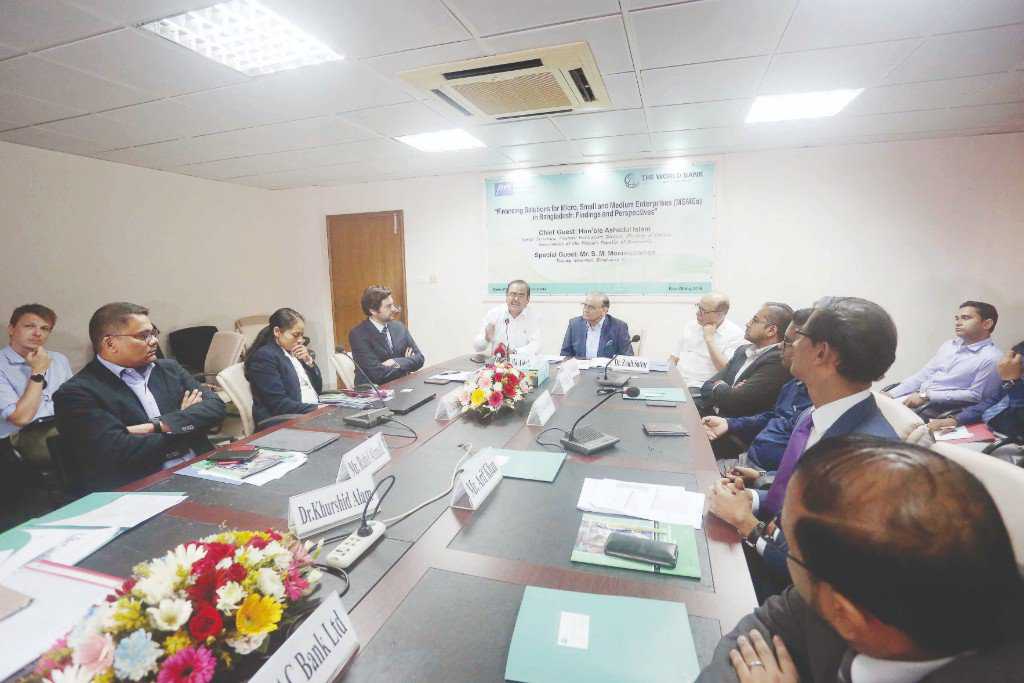Absence of a unified definition bar for financing SMEs

Image collected
There have been multiple definitions deployed since 2003, including by the Economic Census, the Bangladesh Industrial Policy and by the Bangladesh Bank
Absence of a unified definition as to what a micro, small and medium enterprise is makes it all the hard for MSMEs to get access to finance, speakers have said while addressing a workshop.
Policy Research Institute of Bangladesh (PRI) and the World Bank jointly organized the event in the capital on Wednesday.
“Definition of SME is the big challenge for the lenders,” said Rahel Ahmed, managing director and CEO of Prime Bank.
He said that different banks had different definitions of SME, which impacted financing.
IDLC Finance Managing Director and CEO Arif Khan said different agencies of the government defined SME in different ways.
“As a result, it is not clear which should be considered SME or not,” he pointed out.
Brac Bank Managing Director and CEO Selim RF Hussain said confusion over the definition was one among other problems that held back the SME sector in the country.
They talked on the issue in a panel discussion after Senior Financial Sector Specialist of World Bank Mihasonirina Andrianaivo presented a study report on financial solutions for MSME in Bangladesh.
Md Ashadul Islam, senior secretary of the Financial Institutions Division of Finance Ministry, graced the program as chief guest and PRI Chairman Zaidi Sattar delivered the welcome speech.
The World Bank study report says Bangladesh lacks a uniform definition of micro, small and medium enterprises, which has resulted in fundamental knowledge gaps.
There have been multiple definitions deployed since 2003, including by the Economic Census, the Bangladesh Industrial Policy and by the Bangladesh Bank (BB).
Bangladesh Bureau of Statistics (BBS) uses full time employment as the classification basis for the Economic Census, while industry ministry uses the value of fixed assets and the number of employees in the Industrial Policy, the study mentions.
The Bangladesh Bank took the definition mentioned in the Industrial policy in 2011 but changed it in 2016, resetting the fixed asset ambits and number of manpower as the criteria.
The report says that currently the definition set by 2016 Industrial policy is now broadly accepted in policy level, which identifies the enterprises having less than Tk1 million and 15 employed workers as cottage industry, Tk1-7.5 million and 16-30 employees as micro industry, Tk7.5-150 million and 31-120 employees as small industry, and Tk150-500 million and 121-300 employee as medium industry.
Besides, the enterprises, which provide service, having Tk1-20 million and 16-50 manpower are counted as small and those having Tk20-300 million and 51-120 employees as medium.
Financial Institutions Division Senior Secretary Ashadul said that though micro and small entrepreneurs were funded in other countries by capital market, non-bank financial institutions, banks and other platforms, in Bangladesh they depended only on banks.
“But I have observed that getting money from the bank by the SMEs is very complicated,” he stated, adding that banks were not interested to take risk giving small loans.
“As a result, most of the SMEs go to NGOs, money lenders and other informal sources, and take loan at a very high interest rates,” he said.
Prime Bank Managing Director Rahel said that historically most private commercial banks used to finance large enterprises and corporate institutions but later they started to finance the medium entrepreneurs.
“The banks still lag behind as regard disbursing loans for micro and small entrepreneurs,” he claimed.
IDLC Finance MD Arif said many claimed that financing SMEs and women entrepreneurs was loss-incurring.
“But we have observed that it has no risk at all and it rather lowers the non-performing loans,” he said.
Brac Bank MD Selim RF Hussain said basically three barriers including the central bank’s policy were behind the grim situation of the SMEs.
“Bangladesh Bank instructs us to take many documents from the SMEs, which most of them cannot afford,” he added.
Besides, refinancing schemes or other policy supports were not properly going to the real SMEs, he claimed.
Financing Challenges
The World Bank, in the report, has identified five major challenges in financing micro, small and medium entrepreneurs.
It says, firstly, small firms can use limited formal finance like bank and capital market.
Secondly, the firms perceive access to finance as important obstacle to the business environment.
Thirdly, financial constraints faced by MSMEs are widely recognized in the academic literature and other studies.
Fourthly, several factors on the demand and supply can explain large financing gaps for them.
Fifthly, the country’s micro and small entrepreneurs are subject to a number of financing constraints, among them, poor quality of collateral, inadequate documentation and ill-defined business plans.
Recommendations
The World Bank report makes 11 recommendations including establishing a multi-party, central coordinating body to promote the MSME financing and their development.
Among others, it suggests using unified definition, improving the credit information infrastructure, enacting the secure transaction law and creating a register, institutionalizing alternative dispute resolution, promoting an effective payment system and introducing risk sharing facilities.
Source: https://www.dhakatribune.com
Previous Story
- 5 Best Travel Accessories You Need This Summer
- Made in Bangladesh
- Dedicated marketplace to be set up for SME...
- Bangladesh-China-India-Myanmar (BCIM) Economic Corridor no longer listed under...
- To make a bad loan worse
- Marriot to open 7 luxury hotels in Bangladesh...
- Good economy, but bad governance in Bangladesh: Riaz
- ICB seeks share buy-back system for listed cos